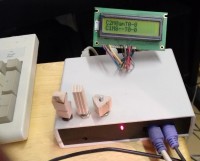Dual PS2 Keyboard MIDI Controller

Reads two PS2-keyboard and transmits MIDI commands. Includes arpeggiator and learn/replay mode.
The core of this project is an ATmega328 with an Arduino bootloader running at 16 MHz. It reads signals from the PS2-keyboards inside interrupt routines that listen to the CLK and DATA line from the keyboard, decodes the received bytes and places them into a first-level ringbuffer. A second stage consumes the bytes to assemble key-codes (carefully keeping track of key-up and key-down events) and fills second-level ringbuffers with key-events. These second-level ringbuffers are continuously monitored in the main loop of the program where the key-events are translated to MIDI sequences. The MIDI commands are subsequently transmitted via the serial line at 31250 baud such that MIDI devices can understand them.
The system features transposing notes and selecting MIDI channels as well as an arpeggiator that operates with two levels of complexity (chord level and harmonic sequence) and has a learn/replay mode.
The full description including the arduino sketch and a brief manual is available at
http://ziemann.web.cern.ch/ziemann/gadget/midi_keyboard/
The system features transposing notes and selecting MIDI channels as well as an arpeggiator that operates with two levels of complexity (chord level and harmonic sequence) and has a learn/replay mode.
The full description including the arduino sketch and a brief manual is available at
http://ziemann.web.cern.ch/ziemann/gadget/midi_keyboard/




Discussie (1 opmerking(en))
Olivier THILL 6 jaar geleden
A few things were not clear to me when I first read the article. I'm a beginner. Now, I understand:
- This is for two keyboards, even if the picture shows only one. There are two violet plugs. Hence the word "dual" in the title. So this will look like an organ rather than a piano.
- These keyboards looks like ordinary keyboards for a PC, but they are called "PS/2" because of their round plugs, different from USB plugs.
- The drawing shows a big central unit, which is an ATmega328 chip. Maybe it could be replaced with an Arduino. This would be more expensive, but this would be easier to program and to connect the wires.
- The drawing shows another chip on the top left corner, which is the chip on the bottom right corner of the photo in the html page given in the link. This is not a Midi chip, which was my first thought. This is an FTDI USB converter. Therefore, the Midi device will be connected to this USB port.
Volker 6 jaar geleden
It is indeed for two keyboards, organ-style. I was surprised that the ATMEga could cope with two keyboards without problems, but it worked smoothly.
You can easily replace the ATMega328+FTDI+crystal +capacitors by and Arduino. There should be no changes in the code necessary.
The circuit works only with old-style PS/2 keyboards, because they send the keypress info with a synchronous serial protocol with CLOCK and DATA at TTL (5V) level that I can directly hook up to IO pins of the ATMega and then decode them in the interrupt service routine in the code.
Do not buy such keyboards new. Ask around and someone will likely have old ones lying around and give them to you. When I started I was thinking about doing something with basically obsolete hardware--the old PS/2-keyboards. Aca sort of a new-life thing.